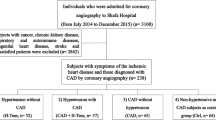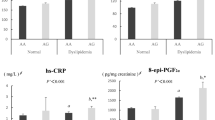Abstract
In individuals with diabetes, a log linear relationship exists between cholesterol levels and cardiovascular disease. Type 2 diabetes (T2D) and Statins, a cholesterol lowering drug, have a complex relationship. Statins are potent modulators of CYP3A4*2 enzyme and endothelial nitric oxide synthase (eNOS) functions in a number of cholesterol-independent, cardio protective actions in T2D. The aim of this study was to evaluate the CYP3A4*2 and eNOS gene mutations in a large number of T2D patients undergoing statin treatments. Blood samples were collected from 386 subjects in which 196 diabetic patients with hyperlipidemia were undergoing statin treatment (108 females and 88 males). The 190 healthy non-diabetic volunteers formed the control group. We investigated single nucleotide polymorphisms in diabetic patients and controls, and found that the statin therapy was not found to be effective in lowering LDL-cholesterol levels. Statistical analysis showed that T2D patients had significantly higher values of not only glucose levels but also a very high value of Triglycerides and cholesterol at the time of presentation. Our results for CYP3A4*2 showed that the genotype TT (wild type) had lower LDL when compared to TC (heterozygous). Similarly, the genotype TC (heterozygous) had lower LDL when compared to CC (homozygous). A similar trend was observed in the GG (wild type) and GT (heterozygous) of eNOS. In conclusion, we have described for the first time a significant correlation of statin treatment and CYP3A4*2 and eNOS gene polymorphisms in T2D, suggesting a new genetic susceptibility factor for insulin resistance and hyperlipidemia in T2D.





Similar content being viewed by others
References
Stumvoll M, Goldstein BJ, van Haeften TW (2005) Type 2 diabetes: principles of pathogenesis and therapy. Lancet 365:1333–1346
Mokdad AH, Ford ES, Bowman BA, Dietz WH, Vinicor F, Bales VS, Marks JS (2003) Prevalence of obesity, diabetes, and obesity-related health risk factors. JAMA 289:76–79
Doria A, Patti ME, Khan CR (2008) The emerging genetic architecture of type 2 diabetes. Cell Metab 8:186–200
van Dam RM (2003) The epidemiology of lifestyle and risk for type 2 diabetes. Eur J Epidemiol 18:1115–1125
Zimmett P, Alberti KGMM, Shaw J (2001) Global and societal implication of the diabetes epidemic. Nature 414:782–787
Fagot-Campagna A, Pettitt DJ, Engelgau MM (2000) Type 2 diabetes among North American children and adolescents: an epidemiologic review and a public health perspective. J Pediatr 136:664–672
Flores JC, Hirschhorn J, Altshuler D (2003) The inherited basis of diabetes mellitus: implications for the genetic analysis of complex traits. Annu Rev Genomics Hum Genet 4:257–291
Barroso I, Luan J, Middelberg RPS et al (2003) Candidate gene association study in type 2 diabetes indicates a role for genes involved in B-Cell function as well as insulin action. PLoS Biol 1:41–55
Stumvoll M (2004) Control of glycaemia: from molecules to men. Minkowski lecture 2003. Diabetologia 47:770–781
Inoue K, Inazawa J, Nakagawa H, Shimada T, Yamazaki H, Guengerich FP, Abe T (1992) Assignment of the human cytochrome P-450 nifedipine oxidase gene (CYP3A4) to chromosome 7 at band q22.1 by fluorescence in situ hybridization. Jpn J Hum Genet 37:133–138
Kolars JC, Lown KS, Schmiedlin-Ren P et al (1994) CYP3A gene expression in human gut epithelium. Pharmacogenetics 4:247–259
Shimada T, Yamazaki H, Mimur M, Inui Y, Guengerich FP (1994) Interindividual variations in human liver cytochrome P-450 enzymes involved in the oxidation of drugs, carcinogens and toxic chemicals: studies with liver microsomes of 30 Japanese and 30 Caucasians. J Pharmacol Exp Ther 270:414–423
Gonzalez FJ, Schmid BJ, Umeno M, Mcbride OW, Hardwick JP, Meyer UA et al (1998) Human P450PCN1: sequence, chromosome localization, and direct evidence through cDNA expression that P450PCN1 is nifedipine oxidase. DNA 7:79–86
Paris PL, Kupelian PA, Hall JM, Williams TL, Levin H, Klein EA, Casey G, Witte JS (1999) Association between a CYP3A4 genetic variant and clinical presentation in African-American prostate cancer patients. Cancer Epidemiol Biomark Prev 8:901–905
Danielson PB (2002) The cytochrome P450 superfamily: biochemistry, evolution and drug metabolism in humans. Curr Drug Metab 3:561–597
Floyd MD, Gervasini G, Masica AL, Mayo G, George AL, Bhat K, Kim RB, Wilkinson GR (2003) Genotype-phenotype associations for common CYP3A4 and CYP3A5 variants in the basal and induced metabolism of midazolam in European- and African-American men and women. Pharmacogenetics 13:595–606
Rogers JF, Rocci ML, Haughey DB, Bertino JS (2003) An evaluation of the suitability of intravenous midazolam as an in vivo marker for hepatic cytochrome P4503A activity. Clin Pharmacol Ther 73:153–158
Lamba JK, Lin YS, Schuetz EG, Thummel KE (2002) Genetic contribution to variable human CYP3A-mediated metabolism. Adv Drug Deliv Rev 54:1271–1294
Finta C, Zaphiropoulos PG (2000) The human cytochrome P4503A locus. Gene evolution by capture of downstream exons. Gene 260:13–23
Kuehl P, Zhang J, Lin Y, Lamba J, Assem M, Schuetz J, Watkins PB, Daly A, Wrighton SA, Hall SD, Maurel P, Relling M, Brimer C, Yasuda K, Venkataramanan R, Strom S, Thummel K, Boguski MS, Schuetz E (2001) Sequence diversity in CYP3A4 promoters and characterization of the genetic basis of polymorphic CYP3A5 expression. Nat Genet 27:383–391
Spurdle AB, Goodwin B, Hodgson E et al (2002) The CYP3A4*1B polymorphism has no functional significance and is not associated with risk of breast or ovarian cancer. Pharmacogenetics 12:355–366
Kadlubar FF, Berkowitz GS, Delongchamp RR et al (2003) The CYP3A4*1B variant is related to the onset of puberty, a known risk factor for the development of breast cancer. Cancer Epidemiol Biomark Prev 12:327–331
Suman G, Jamil K (2006) Novel CYP3A4 Gene polymorphisms in post chemo breast cancer patients. Int J Cancer Res 2:358–366
Huang SM, Goodsaid F, Rahman A, Frueh F, Lesko LJ (2006) Application of pharmacogenomics in clinical pharmacology. Toxicol Mech Methods 16:89–99
Yamada Y, Matsuo H, Watanabe S, Kato K, Yajima K, Hibino T, Yokoi K, Ichihara S, Metoki N, Yoshida H, Satoh K, Nozawa Y (2007) Association of a polymorphism of CYP3A4 with type 2 diabetes mellitus. Int J Mol Med 20:703–707
Sata F, Sapone A, Elizondo G, Stocker P, Miller VP, Zheng W, Raunio H, Crespi CL, Gonzalez FJ (2000) CYP3A4 allelic variants with amino acid substitutions in exons 7 and 12: evidence for an allelic variant with altered catalytic activity. Clin Pharmacol Ther 67:48–56
Mayer B, Hemmens B (1997) Biosynthesis and action of nitric oxide in mammalian cells. Trends Biochem Sci 22:477–481
Hou YC, Janczuk A, Wang PG (1999) Current trends in the development of nitric oxide donors. Curr Pharm Des 5:417–441
Marsden PA, Heng HH, Scherer SW, Stewart RJ, Hall AV, Shi XM, Tsui LC, Schappert KT (1993) Structure and chromosomal localization of the human constitutive endothelial nitric oxide synthase gene. J Biol Chem 268:17478–17488
West IC (2000) Radicals and oxidative stress in diabetes. Diabet Med 17:171–180
Li H, Forstermann U (2000) Nitric oxide in the pathogenesis of vascular disease. J Pathol 190:244–254
Colasanti M, Suzuki H (2000) The dual personality of NO. Trends Pharmacol Sci 21:249–252
Sheng H, Ignarro LJ (1996) Biochemical and immunohistochemical characterization of nitric oxide synthase in the rat retina. Pharmacol Res 33:29–34
Goldstein IM, Ostwald P, Roth S (1996) Nitric oxide: a review of its role in retinal function and disease. Vis Res 36:2979–2994
Hingorani AD, Liang CF, Fatibene J et al (1999) Acommonvariant of the endothelial nitric oxide synthase (Glu298-OAsp) is a major risk factor for coronary artery disease in the UK. Circulation 100:1515–1520
Wang XL, Sim AS, Badenhop RF et al (1996) A smoking-dependent risk of coronary artery disease associated with a polymorphism of the endothelial nitric oxide synthase gene. Nat Med 2:41–45
Stangl K, Cascorbi I, Laule M et al (2000) High CA repeat numbers in intron 13 of the endothelial nitric oxide synthase gene and increased risk of coronary artery disease. Pharmacogenetics 10:133–140
Colombo MG, Paradossi U, Andreassi MG, Botto N, Manfredi S, Masetti S et al (2003) Endothelial nitric oxide synthase gene polymorphisms and risk of coronary artery disease. Clin Chem 49:389–395
Casas JP, Bautista LE, Humphries SE, Hingorani AD (2004) Endothelial nitric oxide synthase genotype and ischemic heart disease: a meta-analysis of 26 studies involving 23028 subjects. Circulation 119:1359–1365
Forte P, Copland M, Smith LM, Milne E, Sutherland J, Benjamin N (1997) Basal nitric oxide synthesis in essential hypertension. Lancet 349:837–842
Nishevitha NS, Angeline T, Jeyaraj N (2009) Endothelial nitric oxide synthase (eNOS) Glu298 → Asp polymorphism (G894T) among south Indians. Indian J Med Res 129:68–71
Monti LD, Barlassina C, Citterio L, Galluccio E, Berzuini C, Setola E, Valsecchi G, Lucotti P, Pozza G, Bernardinelli L, Casari G, Piatti P (2003) Endothelial nitric oxide synthase polymorphisms are associated with type 2 diabetes and insulin resistance syndrome. Diabetes 52:1270–1275
Shah RV, Goldfine AB (2012) Statins and risk of new-onset diabetes mellitus. Circulation 126(18):e282–e284
Willrich MA, Hirata MH, Hirata RD (2009) Statin regulation of CYP3A4 and CYP3A5 expression. Pharmacogenomics 10(6):1017–1024
Kureishi Y, Luo Z, Shiojima I et al (2000) The HMG-CoA reductase inhibitor simvastatin activates the protein kinase Akt and promotes angiogenesis in normocholesterolemic animals. Nat Med 6:1004–1010
Lamprecht M, Oettl K, Schwaberger G, Hofmann P, Greilberger JF (2009) Protein modification responds to exercise intensity and antioxidant supplementation. Med Sci Sports Exerc 41:155–163
Syed R, Biyabani MU, Prasad S, Deeba F, Jamil K (2011) Evidence of association of a common variant of the endothelial nitric oxide synthase gene (Glu298 → Asp polymorphism) to coronary artery disease in South Indian population. J Med Genet Genomics 3:13–18
Tayeb MT, Clark C, Sharp L, Haites NE, Rooney PH, Murray GI, Payne SN, McLeod HL (2002) CYP3A4 promoter variant is associated with prostate cancer risk in men with benign prostate hyperplasia. Oncol Rep 9:653–655
Staatz C, Goodman L, Tett S (2010) Effect of CYP3A4 and ABCB1 single nucleotide polymorphisms on the pharmacokinetics and pharmacodynamics of calcineurin inhibitors: part II. Clin Pharmacokinet 49:207–221
Miyamoto Y, Saito Y, Kajiyama N, Yoshimura M, Shimasaki Y, Nakayama M, Kamitani S, Harada M, Ishikawa M, Kuwahara K, Ogawa E, Hamanaka I, Takahashi N, Kaneshige T, Teraoka H, Akamizu T, Azuma N, Yoshimasa Y, Yoshimasa T, Itoh H, Masuda I, Yasue H, Nakao K (1998) Endothelial nitric oxide synthase gene is positively associated with essential hypertension. Hypertension 32:3–8
Nakayama M, Yasue H, Yoshimura M, Shimasaki Y, Kugiyama K, Ogawa H, Motoyama T, Saito Y, Ogawa Y, Miyamoto Y, Nakao K (1999) T-786 → C mutation in the 5′-flanking region of the endothelial nitric oxide synthase gene is associated with coronary spasm. Circulation 99:2864–2870
Wang XL, Wang J (2000) Endothelial nitric oxide synthase gene sequence variations and vascular disease. Mol Genet Metab 70:241–251
Angeline T, Krithiga HR, Isabel W, Asirvatham AJ, Poornima A (2011) Endothelial nitric oxide synthase gene polymorphism (G894T) and diabetes mellitus (type II) among South Indians. Oxid Med Cell Longev 4:0900–1942
Srivastava K, Biswas UK, Narang R, Varghese JJ, Das N (2005) Prevalence of eNOS Glu298Asp polymorphism in healthy volunteers from a region of northern India. Community Genet 8:180–183
Takahashi T, Takahashi K, Yamashina M, Maesawa C, Kajiwara T, Taneichi H, Takebe N, Kaneko Y, Masuda T, Satoh J (2009) Association of the TNF-{alpha}-C-857T polymorphism with resistance to the cholesterol-lowering effect of HMG-CoA reductase inhibitors in type 2 diabetic subjects. Diabetes Care 33:463–466
Acknowledgements
We are thankful to all the volunteers and patients who willingly accepted to be part of the study, and we thank BMMRC for the facilities provided for this work.
Author information
Authors and Affiliations
Corresponding author
Rights and permissions
About this article
Cite this article
Jamil, K., Kandula, V., Kandula, R. et al. Polymorphism of CYP3A4*2 and eNOS genes in the diabetic patients with hyperlipidemia undergoing statin treatment. Mol Biol Rep 41, 6719–6727 (2014). https://doi.org/10.1007/s11033-014-3557-z
Received:
Accepted:
Published:
Issue Date:
DOI: https://doi.org/10.1007/s11033-014-3557-z




